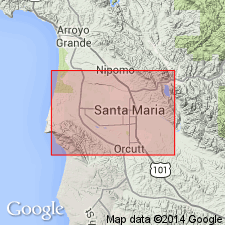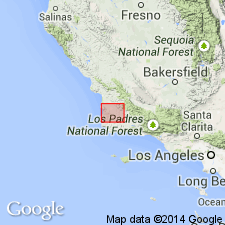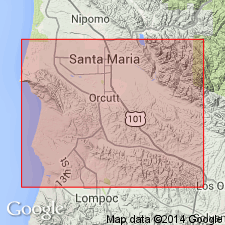
- Usage in publication:
-
- Foxen formation
- Modifications:
-
- [First used]
- AAPG geologic province:
-
- Santa Maria basin
Summary:
Pg. 459. Foxen formation. Named on stratigraphic column. Described as fine sandstone and diatomite 750 feet thick. Underlies the lower Fernando; overlies Harris formation. Age is Pliocene.
Source: US geologic names lexicon (USGS Bull. 1200, p. 1410).

- Usage in publication:
-
- Foxen formation
- Modifications:
-
- Original reference
- Dominant lithology:
-
- Mudstone
- Siltstone
- AAPG geologic province:
-
- Santa Maria basin
Summary:
Pg. 1336 (fig. 1), 1340 (table 1), 1353-1355. Consists chiefly of mudstone and siltstone but includes fine-grained silty sandstone and fine-grained volcanic ash. Maximum exposed thickness 800 feet (at type locality). In complete sections, such as type region, gradationally overlies diatomaceous strata of Sisquoc and grades upward into Cebada fine-grained member of Careaga sandstone. Type region designated.
Type region: north slope of western Purisima Hills, Santa Maria district, Santa Barbara Co., southern CA.
Source: US geologic names lexicon (USGS Bull. 1200, p. 1410).

- Usage in publication:
-
- Foxen mudstone*
- Modifications:
-
- Revised
- AAPG geologic province:
-
- Santa Maria basin
Summary:
Pg. 10 (table), 36-42. Foxen mudstone. History of name given. Term mudstone used as a more appropriate lithologic designation. As defined here, formation is not represented along Foxen Canyon, which furnished the name and was presumably intended by proposers as the type region. Diatomaceous strata along and near Foxen Canyon are now referred to the Monterey shale and the upper part of Sisquoc. In most sections where the Foxen is thick, typical diatomaceous strata of the Sisquoc formation are separated from typical Foxen strata by a transition zone as much as 100 feet thick. [Age is] middle(?) and late Pliocene.
[Note: reference listed in US geologic names lexicon (USGS Bull. 1200, p. 1410) is misprint.]
Source: US geologic names lexicon (USGS Bull. 1200, p. 1410).
For more information, please contact Nancy Stamm, Geologic Names Committee Secretary.
Asterisk (*) indicates published by U.S. Geological Survey authors.
"No current usage" (†) implies that a name has been abandoned or has fallen into disuse. Former usage and, if known, replacement name given in parentheses ( ).
Slash (/) indicates name conflicts with nomenclatural guidelines (CSN, 1933; ACSN, 1961, 1970; NACSN, 1983, 2005, 2021). May be explained within brackets ([ ]).

